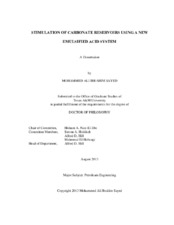| dc.contributor.advisor | Nasr-El-Din, Hisham | |
| dc.creator | Sayed, Mohammed Ali Ibrahim | |
| dc.date.accessioned | 2013-12-16T19:56:41Z | |
| dc.date.available | 2015-08-01T05:48:35Z | |
| dc.date.created | 2013-08 | |
| dc.date.issued | 2013-05-15 | |
| dc.date.submitted | August 2013 | |
| dc.identifier.uri | https://hdl.handle.net/1969.1/150980 | |
| dc.description.abstract | The scope of work can be divided into; the measurement of the rheological properties of a new emulsified acid system that can be suitable for high temperature applications, a study of the performance of the new emulsified acid in stimulating both calcite and dolomite formations, measuring the reaction rate and diffusion coefficient when the new emulsified acid systems react with both calcite and dolomite, and testing the new emulsified acid using core samples obtained from carbonate reservoirs.
The droplet size has a practical impact on the performance of emulsified acid. A good understanding and characterization of the emulsified acid by its size distribution will lead to better understanding of its stability, rheology and how it reacts with carbonate rocks. The influence of the concentration of the new emulsifier on the droplet size, droplet size distribution and upon the rheology of emulsified acids is studied in detail.
The emulsified acid reaction kinetics with calcite rocks was studied before in few studies, and very little work was done with dolomite. One of the main objectives of the present work is to study in detail the reaction of the emulsified acid with both calcite and dolomite rocks using the rotating disk apparatus.
Most of the previous studies on the emulsified acid were done using core samples that were saturated with brine or deionized water. One of the main objectives of the present work is to study in detail the effect of the presence of crude oil in the reservoir rock on the performance of emulsified acids.
Lastly, an innovative technique of emulsifying the chelating agents is evaluated for high temperature applications. The rheology of the emulsified chelating agent is measured using an HPHT rheometer. Also, the reaction of the new emulsified chelating agent with calcite is studied using the rotating disk apparatus, and coreflood experiments were performed using chelating agents and calcite core samples. | en |
| dc.format.mimetype | application/pdf | |
| dc.language.iso | en | |
| dc.subject | Emulsified Acid | en |
| dc.subject | Coreflood | en |
| dc.subject | Reaction Kinetics | en |
| dc.subject | Dolomite | en |
| dc.subject | Calcite | en |
| dc.subject | Rheology | en |
| dc.title | Stimulation of Carbonate Reservoirs Using a New Emulsified Acid System | en |
| dc.type | Thesis | en |
| thesis.degree.department | Petroleum Engineering | en |
| thesis.degree.discipline | Petroleum Engineering | en |
| thesis.degree.grantor | Texas A & M University | en |
| thesis.degree.name | Doctor of Philosophy | en |
| thesis.degree.level | Doctoral | en |
| dc.contributor.committeeMember | Holditch, Steven | |
| dc.contributor.committeeMember | Hill, Alfred | |
| dc.contributor.committeeMember | El-Halwagi, Mahmoud | |
| dc.type.material | text | en |
| dc.date.updated | 2013-12-16T19:56:41Z | |
| local.embargo.terms | 2015-08-01 | |


